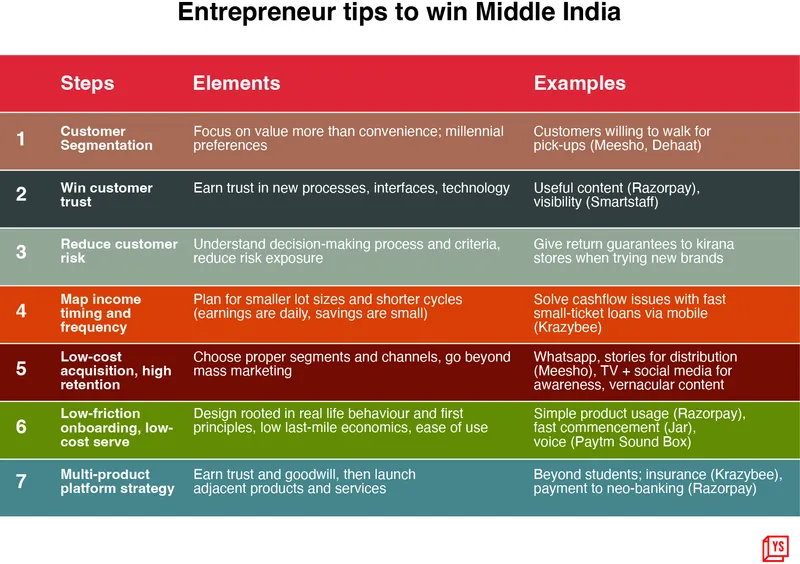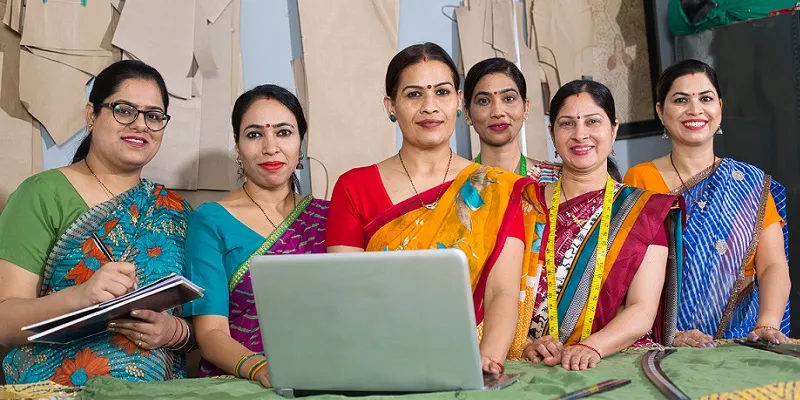Startups for Middle India: stories and success tips for the next 500 million customers
This must-read book provides a useful roadmap for the next wave of entrepreneurs who want to target new opportunities in India. Here are some key takeaways and tips.
Launched in 2012, YourStory's Book Review section features over 345 titles on creativity, innovation, entrepreneurship, and digital transformation. See also our related columns The Turning Point, Techie Tuesdays, and Storybites.
Aspiring entrepreneurs will find inspiring stories and insightful frameworks for their journey in this new book, Winning Middle India: The Story of India’s New-Age Entrepreneurs by Bala Srinivasa and TN Hari.
The authors profile a new generation of founders who are leveraging platform business models, smartphones, and digital behaviour shifts of Indian consumers. They hold the key to unlocking vast new opportunities for consumers and investors.
See my reviews of the related books Startup Compass, Startup Launchpad, From Startup to Exit, Masters of Scale, Fail-safe Startup, The Messy Middle, Funding Your Startup, and Venture Capital Investments.
Bala Srinivasa is Managing Director at Arkam Ventures, and has 21 years of experience including two successful startups. TN Hari is an angel investor and startup advisor, and co-author of Saying No to Jugaad: The Making of Bigbasket (see my book review here).
See also our picks of ‘Top 10 Books of the Year for Entrepreneurs’ from the past ten years: 2021, 2020, 2019, 2018, 2017, 2016, 2015, 2014, 2013, and 2012.
Here are my key clusters of takeaways from this compelling 185-page book, summarised as well in the table below. The material is written in straightforward storytelling style, backed up with lots of data and analysis.

1. Foundations
Almost 50 percent of India’s 75,000 startups are outside the eight metros, observes GAME Founder Ravi Venkatesan, in the book’s foreword. Democratisation of ideas, capital and founders is spreading the entrepreneurship movement.
Entrepreneurs in smaller towns now have the confidence, capability and capital to succeed in their own ventures, and the flywheel of early breakthroughs is gathering speed. “Government policies can be a headwind or tailwind, but the locomotive is the entrepreneur,” he says.
In the time since India’s 1991 reforms, the upper-middle class has benefited the most, but prosperity now needs to come to the next 500 million below the top of the pyramid. The authors call this segment Middle India.
Digital media and savvy entrepreneurs can help tackle the wicked problems of fragmented demand, physical operational costs, customer acquisition, low education levels, and underemployment. Serendipitous factors along the way for the entrepreneurs have been Aadhaar, UPI, and the Jio effect.
The authors trace India’s journey in a number of trajectories, such as the rise of cricket stars from small towns, and evolution of movie themes (agrarian struggle, urban poverty, NRIs, modern identity).
Early waves of tech entrepreneurship were in the IT services boom, followed by startups using technology to address pan-India solutions for the top 100 million consumers in India. Companies like Flipkart inspired entrepreneurs to solve India-centric problems, followed by a string of IPOs (Zomato, Nykaa, Freshworks).
The next wave of audacious and persevering entrepreneurs is addressing the needs of Middle India (family incomes of Rs 3 lakh to Rs 20 lakh), who prioritise value over conveniences like 10-minute grocery delivery, the authors observe.
The scale and speed of digital platforms and marketplaces have kicked off virtuous cycles of visibility, trust, income growth, and upskilling. This has applied to labour markets as well as tourism, thanks to savvy entrepreneurs with creative business models.
Such models include product innovations like sachet packaging and pricing, pioneered by Chinni Krishnan (Chik shampoo, CavinKare). Banks have yet to discover such sachet models, leaving the door open for fintechs.
“The customer often does not have an affordability problem but a cash flow problem,” the authors observe.

[Year in Review 2021] How women entrepreneurs pivoted during the pandemic and saw tangible results
2. Pandemic impact
“The speed and ferocity of the COVID-19 crisis overwhelmed millions of Indians,” the authors observe. But as a silver lining, it also spurred digital transformation and behaviour change in health, education, entertainment, and retail, and venture investment flows resulted in a wide range of new unicorns.
“It’s hard to overstate the impact of the COVID-19 pandemic in changing the trajectory of digitisation in India,” they add. Even kirana stores stepped up their digital activities, and older non-millennials increased their online behaviours.
“The COVID-19 crisis also opened up deeptech opportunities in India by removing regulatory barriers in record time,” the authors observe, citing drone delivery of vaccines.

3. Examples
The authors provide a range of examples of the business models and strategies of startups targeting Middle India.
Razorpay began with safe, affordable, and easy payment capabilities for online businesses. Its patience and planning included content marketing and face-to-face events, the authors describe. They helped information-starved businesses in smaller cities, and offered online self-service options. At scale, unit economics became profitable for the top cohorts.
Dehaat tackled the risk aversion of farmers by providing full-lifecycle advisory services online, as well as an income guarantee to try out new crops. They roped in local micro-entrepreneurs as distributors, but without the need for doorstep delivery.
“Farmers were willing to exchange convenience for value. This has been a common trend across middle India,” the authors observe. “One of the defining elements of Middle India is that it is time rich and money poor,” they add.
Krazybee launched tests outside college campuses to assess the market need for small loans for purchases of laptops, phones, and travel. Its online business model helped low-cost customer acquisition and servicing for Middle India as well. It developed its own algorithms for credit assessment and risk management.
Meesho helped small businesses enter the ecommerce space, and built integrations via WhatsApp messaging and stories. Women entrepreneurs helped promote unbranded products in their communities.
Urban Company created a full-stack technology-powered marketplace for home services. It retained control over quality and consistency of services, and features like consumer ratings helped drive the value and demand for upskilling. It addressed the aspirational and experiential needs of lower-income segments by offering quality at lower price points.
Jumbotail aims at modernising local kirana stores with mobile apps for workflow. In the early days, it also recharged their phones to enable transactions.
“One of the main lessons here is to focus on the user experience and solve for gaps without waiting for all pieces to be in place,” the authors observe.
“Jumbotail realised customer experience and loyalty was the most important ‘north star’ for any kirana store,” they add. They would do anything to retain a customer who can easily go to another nearby store.
Other examples include Jar (savings app for millennials), Smartstaff (workforce management platform for contractors and blue collar workers), RailYatri (predicting train arrival times based on crowdsourced mobile user data), Lokal (hyperlocal vernacular news), and Animall (marketplace for cattle buyers and sellers).
Key lessons from these examples are captured in an outstanding chapter on the playbook for succeeding in Middle India.

[Year in Review 2021] 10 inspiring stories of people who made the world a better place
4. The road ahead
In addition to entrepreneurs and enablers, the authors make a strong case for social reformers who tackle challenges like discrimination, oppression, social stigmas, and extreme poverty.
Exemplars of such changemakers with compassionate vision include Phoolbasan Bai Yadav (self-help groups for women’s empowerment), Samina Bano (inclusive classrooms, RTE in UP), Govindappa Venkataswamy (Aravind Eye Hospital), cooperatives like Amul, and the Industree artisan platform.
“India’s glory lies in thousands of startups, small businesses being unshackled to emerge as the large enterprises of tomorrow,” the authors sum up.
The wave of entrepreneurship can truly create a mass flourishing, in the words of Edmund Phelps. It will be driven by the need of millions to develop new products and solve problems.
India’s youth bulge can be a peril rather than a promise if not harnessed well, the authors caution. Youth need to be better skilled to go beyond unfulfilling jobs, and access to entrepreneurship resources can help here.
Ultimately, it is the team culture and strategy that are key. Aspiring entrepreneurs should be willing to learn from and empathise with Middle India, shed prior biases and prejudices, and articulate a compelling vision. Eventually, venture capitalists who grew up in Middle India will also be funding their ideas.
In sum, this is a must-read book for aspiring entrepreneurs and a useful guide for innovators looking for new opportunities in emerging economies like India.
YourStory has also published the pocketbook ‘Proverbs and Quotes for Entrepreneurs: A World of Inspiration for Startups’ as a creative and motivational guide for innovators (downloadable as apps here: Apple, Android).
(The copy was updated to add an image and to add names of two startups)







